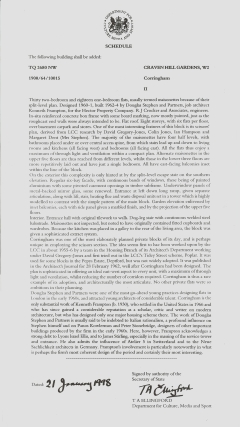The listing procedure started in 1991. Corringham was
thirty years old, the minimum age for a building to be
considered for listing. Lisa Zaffern, one of Corringham's
longstanding residents, recognised the architectural
significance of the building and wrote to English
Heritage to have it listed. English Heritage prepared a
report for the Department of the Environment, who in
those days had the final say about listing buildings.
The report stated that Corringham ranked "among the
half-dozen or so most interesting blocks of flats
built in London in the first half of the 1960s".
At the end of 1991 English Heritage decided
to earmark the building
for listing but to postpone an actual listing application
- quite possibly because it was felt that the Department
of the Environment was not in favour of listing housing.
English Heritage officially recommended Corringham for
listing in 1996. For a copy of the recommendation
document (PDF 0.2Mb)
click here.
To view a copy of the 1998 official Grade II listing
documentation (PDF 1.2Mb)
click here.
What is listing?
A building is called listed if it is included in a
register of buildings of special architectural or
historic interest: the "list". This list is maintained
by the government body, English Heritage, on behalf of
the Department for Culture, Media and Sport.
When a building is listed, its interior and exterior are
described in detail and the building is legally protected
on the basis of these records. Any changes to it must
first receive listed building consent from the local
planning authority - which for Corringham is
Westminster City Council
(WCC).
The local planning authority can approve minor changes
to listed buildings, but it will seek the advice of
English Heritage before authorising alterations that
have a larger visual or structural impact.
Listed buildings are graded to show their relative
importance. There are three main listing grades. Grade
I listed buildings are of "exceptional interest".
Grade II* listed buildings are considered "particularly
important and of more than special interest", and a
building is Grade II listed if it is of "special
interest, warranting every effort to preserve it".
Listing is not intended to stop a building from being
used, maintained, updated or even changed. Over 90% of
applications result in permission being granted. Listing
merely ensures that any alterations respect the
character of the building.
Post-war listing
All buildings constructed before 1700 and most of those
built between 1700 and 1840 are automatically listed
because of their historic value. After 1840 the listing
criteria become tighter because, since then, more
buildings were erected, and most of them still exist
today. According to English Heritage post-war buildings
have to be "exceptionally important" to be listed.
Generally, a building has to be over thirty years old
before it can be considered for listing. English
Heritage started listing post-war buildings in 1987,
and selected only 189 buildings until 1995. In that
year it was decided to open up the listing of post-war
buildings to public debate and consultation.
Corringham was Grade II listed a few years later in 1998.
